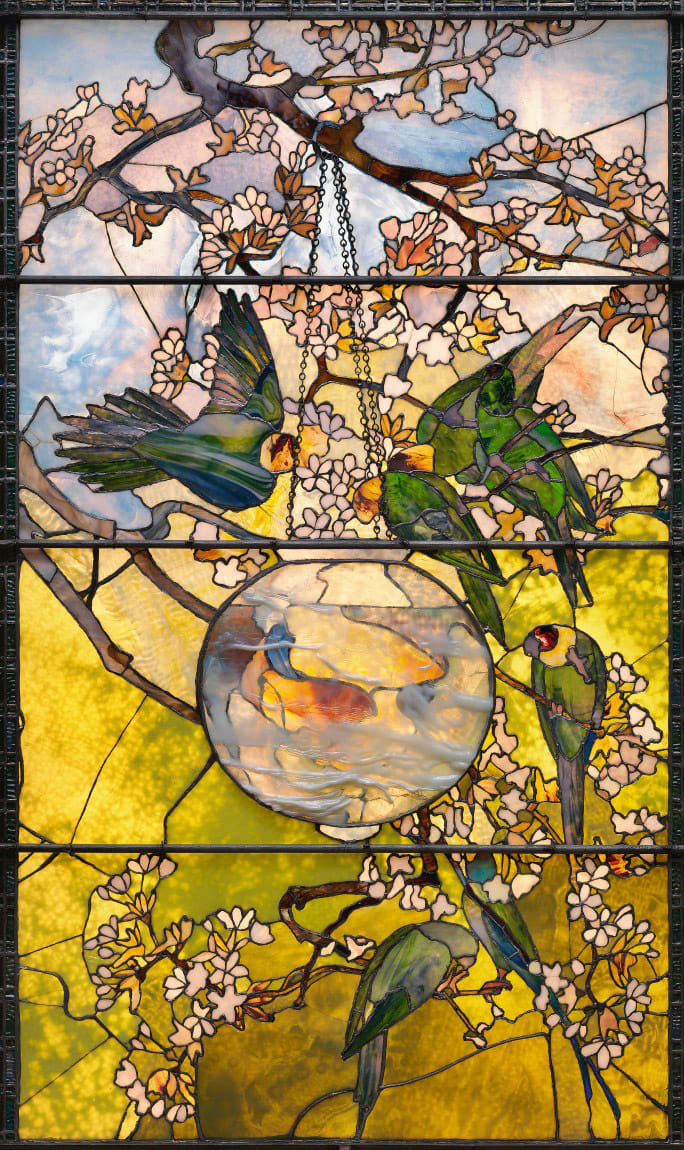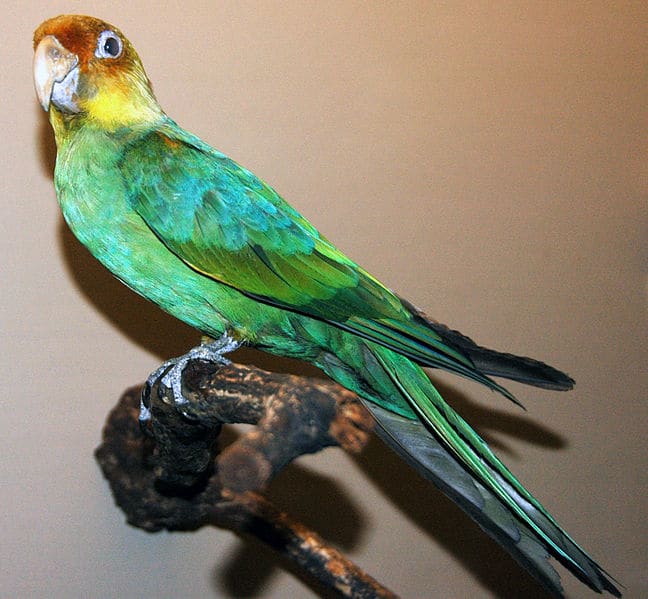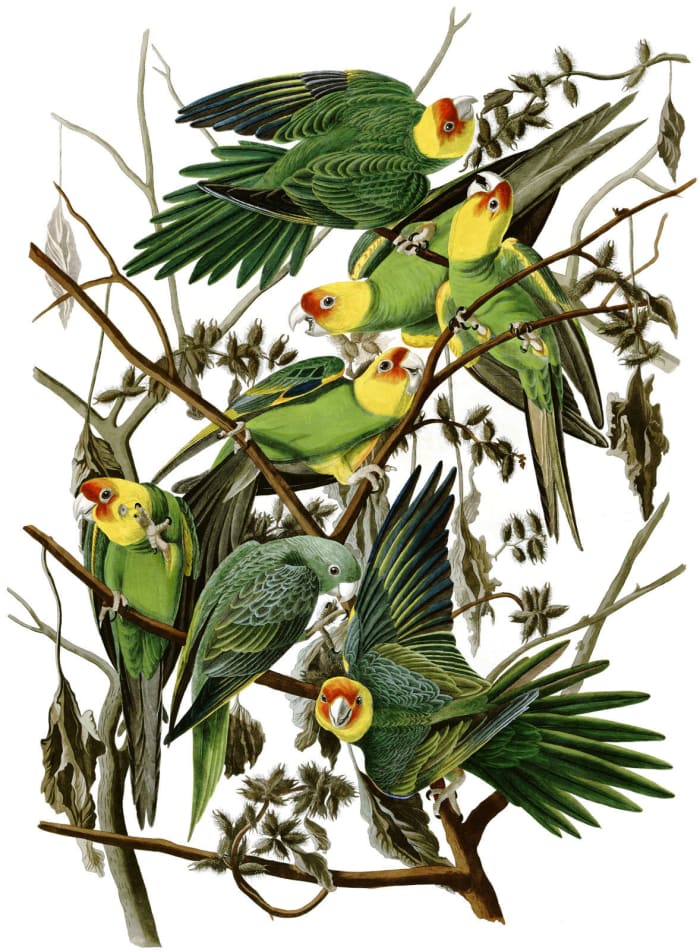A native species of parakeet once flew in our skies. The Carolina parakeet was found in Eastern, Southern and Plains states, and lived in old forests along rivers.
I never knew that until I recently came across this beautiful stained glass window Louis Comfort Tiffany designed in 1889 that is now in the collection of the Museum of Fine Arts in Boston.
Measuring approximately seventy-seven inches high and thirty-nine inches wide and composed only of colored glass held together with lead and copper strips, Parakeets and Goldfish Bowl features a fish bowl suspended by real chains from the branch of a blossoming pink cherry tree. Inside the fishbowl, colors and reflections swirl, suggesting the forms of orange-and-red fish swimming in water. The bowl is surrounded by six Carolina parakeets in different poses, possibly conveying their different personalities. According to the museum, this is an important window and a triumph of craftsmanship. It was painstakingly constructed out of rough and polished pieces of opalescent and “favrile” glass (the latter patented by L. C. Tiffany in 1894), which creates effects unlike traditional stained glass windows that rely on uniform, solid-colored pieces of glass along with enameling, paint, or ink to create detailed images. The Parakeets window was Tiffany’s first attempt at using favrile glass only.

Louis Comfort Tiffany’s “Parakeets and Goldfish Bowl,” 1889.
Courtesy of the Museum of Fine Arts, Boston
In a booklet telling the story of this window, author Nonie Gadsden, the Katharine Lane Weems Senior Curator of American Decorative Arts and Sculpture at the museum, says that it is one of a small number that best illustrates Tiffany’s personal aesthetic, as it was not a commission and was instead made specifically to showcase his firm’s design and glass manufacturing skills. It was unveiled at the World’s Columbian Exposition in Chicago in 1893, where it was admired by a reported 1.8 million people. In a promotional brochure for the fair, Tiffany stated that it “illustrate[s] most perfectly the possibilities of American glass.” And it was, indeed, hailed as a revolutionary breakthrough in the production of stained glass and a triumph in American art.
Tiffany borrowed the colorful parakeets — a vivid green and yellow, with a soft red patch around the top of their head and eyes — from an actual study of the species by John James Audubon, the great American naturalist, ornithologist, and painter of the nineteenth century. Audubon’s famous image of the Carolina Parrot, as he called the species, was first published as a hand-colored engraving in Birds of America in 1826. Tiffany owned a later edition of Birds of America, called the Bien edition, published between 1858-1860.
Tiffany’s version evokes a calmer and quieter tone than Audubon’s, and his choice of these birds is particularly notable, as not only was the Carolina parakeet vibrant and lively, it was also the only parrot indigenous to the United States. In his quest to create a distinctive piece of American art, Tiffany chose a distinctive American subject.
But by the time Tiffany was creating this window, Carolina parakeets were imperiously endangered, a fact regularly reported on in period newspapers and magazines. Once seen in large flocks, they had severely dwindled in population in the late nineteenth century. Although many farmers valued them for controlling invasive cockleburs, others considered them destructive pests and they were killed in huge numbers. The ones that survived later became victims of human settlement, deforestation and modern industrialization.

A mounted Carolina parakeet on display at the Field Museum of Natural History, Chicago, Illinois.
Courtesy of James St. John/CC BY 2.0
Gadsden says that Tiffany would have been aware of this and could have been making a social statement by portraying a native North American species that was being eliminated by modern life. The fragile status of the Carolina parakeets would have been subtly emphasized by depicting them on blossoming cherry branches, a symbol of life’s ephemeral nature.
According to the John James Audubon Center in Pennsylvania, the last known wild parakeet was killed in Okeechobee County, Florida, in 1904, and the last captive bird died at the Cincinnati Zoo on February 21, 1918. It was a male named Incas that died within a year of his mate, Lady Jane. It was not until 1939, however, that the species was thought to be officially extinct — six years after Tiffany’s death in 1933.
Gadsden says that in material, technique and design, the Parakeets window represents the tremendous ambition and success of Louis C. Tiffany in creating a style of art that is a monument to American innovation and creativity in that quintessentially American medium: stained glass.
It’s also a poignant memorial to a bird that may no longer be here, but one that will forever live on in that beautiful glass.
You might also like:
Windows to His Soul: A Renowned Tiffany Glass Expert
Tiffany Lamps: How to Tell Real From Fake
The Hartwell Memorial Window | Artwork Spotlight: In this short video, curators Sarah Kelly Oehler and Elizabeth McGoey and conservators Rachel Sabino and Diane Roberts Rousseau offer insight into the extraordinary window at the Art Institute of Chicago.










